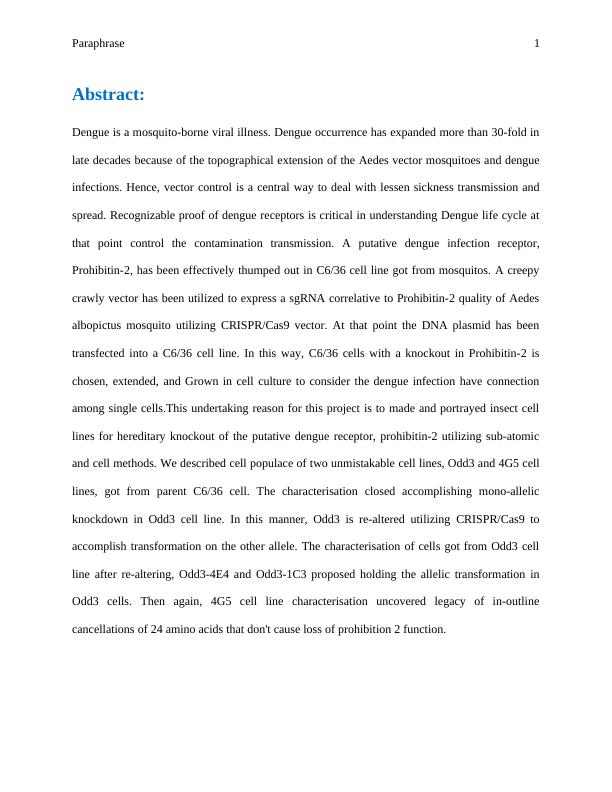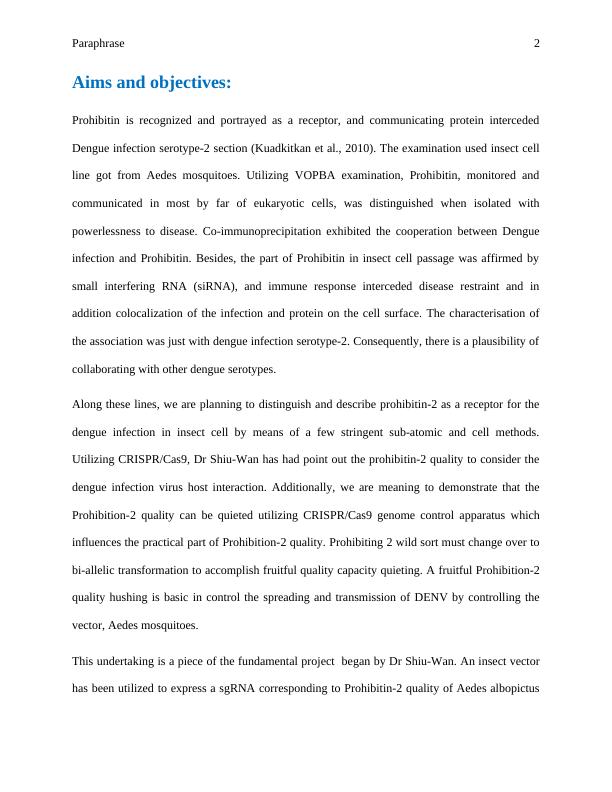Ask a question from expert
Article on Dengue: Doc
11 Pages2881 Words260 Views
Added on 2019-10-18
Article on Dengue: Doc
Added on 2019-10-18
BookmarkShareRelated Documents
Running head: ParaphrasePARAPHRASE[Document subtitle][DATE][COMPANY NAME][Company address]

Paraphrase1Abstract:Dengue is a mosquito-borne viral illness. Dengue occurrence has expanded more than 30-fold inlate decades because of the topographical extension of the Aedes vector mosquitoes and dengueinfections. Hence, vector control is a central way to deal with lessen sickness transmission andspread. Recognizable proof of dengue receptors is critical in understanding Dengue life cycle atthat point control the contamination transmission. A putative dengue infection receptor,Prohibitin-2, has been effectively thumped out in C6/36 cell line got from mosquitos. A creepycrawly vector has been utilized to express a sgRNA correlative to Prohibitin-2 quality of Aedesalbopictus mosquito utilizing CRISPR/Cas9 vector. At that point the DNA plasmid has beentransfected into a C6/36 cell line. In this way, C6/36 cells with a knockout in Prohibitin-2 ischosen, extended, and Grown in cell culture to consider the dengue infection have connectionamong single cells.This undertaking reason for this project is to made and portrayed insect celllines for hereditary knockout of the putative dengue receptor, prohibitin-2 utilizing sub-atomicand cell methods. We described cell populace of two unmistakable cell lines, Odd3 and 4G5 celllines, got from parent C6/36 cell. The characterisation closed accomplishing mono-allelicknockdown in Odd3 cell line. In this manner, Odd3 is re-altered utilizing CRISPR/Cas9 toaccomplish transformation on the other allele. The characterisation of cells got from Odd3 cellline after re-altering, Odd3-4E4 and Odd3-1C3 proposed holding the allelic transformation inOdd3 cells. Then again, 4G5 cell line characterisation uncovered legacy of in-outlinecancellations of 24 amino acids that don't cause loss of prohibition 2 function.

Paraphrase2Aims and objectives:Prohibitin is recognized and portrayed as a receptor, and communicating protein intercededDengue infection serotype-2 section (Kuadkitkan et al., 2010). The examination used insect cellline got from Aedes mosquitoes. Utilizing VOPBA examination, Prohibitin, monitored andcommunicated in most by far of eukaryotic cells, was distinguished when isolated withpowerlessness to disease. Co-immunoprecipitation exhibited the cooperation between Dengueinfection and Prohibitin. Besides, the part of Prohibitin in insect cell passage was affirmed bysmall interfering RNA (siRNA), and immune response interceded disease restraint and inaddition colocalization of the infection and protein on the cell surface. The characterisation ofthe association was just with dengue infection serotype-2. Consequently, there is a plausibility ofcollaborating with other dengue serotypes.Along these lines, we are planning to distinguish and describe prohibitin-2 as a receptor for thedengue infection in insect cell by means of a few stringent sub-atomic and cell methods.Utilizing CRISPR/Cas9, Dr Shiu-Wan has had point out the prohibitin-2 quality to consider thedengue infection virus host interaction. Additionally, we are meaning to demonstrate that theProhibition-2 quality can be quieted utilizing CRISPR/Cas9 genome control apparatus whichinfluences the practical part of Prohibition-2 quality. Prohibiting 2 wild sort must change over tobi-allelic transformation to accomplish fruitful quality capacity quieting. A fruitful Prohibition-2quality hushing is basic in control the spreading and transmission of DENV by controlling thevector, Aedes mosquitoes.This undertaking is a piece of the fundamental project began by Dr Shiu-Wan. An insect vectorhas been utilized to express a sgRNA corresponding to Prohibitin-2 quality of Aedes albopictus

Paraphrase3mosquito utilizing CRISPR/Cas9 vector. At that point the DNA plasmid has been transfectedinto a C6/36 cell line. Hence, C6/36 cells with a hit in Prohibitin-2 is chosen by restrictedweakening, extended, and Grown in cell culture to consider the dengue infection havecommunication among single cells. Thus, the destinations of this venture are to make and keepup cell lines got from C6/36 that already thumped out, and describe these cells populaces forhereditary knockout of the putative dengue receptor, prohibitin-2. After cell culture, DNA isremoved, opened up by PCR, and keep running on gel electrophoresis to distinguish INDELSthat will be affirmed by DNA sequencing.Study design and methodology:Study Design:This task had been begun by Dr Shiu-Wan Chan before we began, and we took part in therecognizable proof and characterisation utilizing cell and sub-atomic systems. To give an outlineof undertaking work process (Figure 4), the examination configuration is portrayed in threesections: the part done by DR Shiu-Wan Chan, that part done by Master understudies, and futurerecommendations. The initial segment incorporates the accompanying strategies and techniques: To start with, the cloning of sgRNA into plasmid vectors (E. coli). The vectors encode thePuromycin protection quality (as a selectable marker to demonstrate the accomplishment of atransfection), cas9. Furthermore, transfection of the plasmid vector by utilizing a lipid. The cellsproceed to develop and entry keeping up determination weight by keeping puromycin in thedevelopment medium (with and without puromycin). Following 1-2 weeks, countless cells wereexecuted by the puromycin, demonstrating that they didn't take up or had lost the plasmid withthe puromycin protection quality. The cells that stayed developing in the puromycin-containing

End of preview
Want to access all the pages? Upload your documents or become a member.
Related Documents
Identification and Characterisation of Prohibitin-2 as a Receptor for Dengue Virus in Insect Celllg...
|5
|2790
|379
Tracking of Indels by Decomposition (TIDE) Methodlg...
|2
|895
|630
The Parental Cell line C6/36lg...
|3
|941
|485
Dengue Fever: Symptoms, Transmission, and Global Burdenlg...
|14
|9196
|318
Dengue Fever: Transmission, Global Burden, and Manifestationslg...
|17
|9743
|166